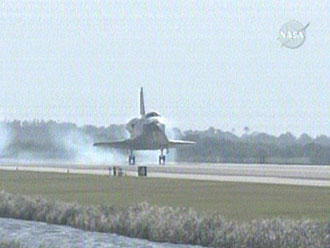STS-122
Report #05
Saturday, February 9, 2008 – 5:30 p.m. CST
Mission Control Center, Houston, Texas
HOUSTON – Space shuttle Atlantis delivered the European Space Agency’s Columbus science laboratory to the International Space Station today, but the actual installation of the module will be delayed by one day.
What wasn’t delayed, however, was the official crew rotation of ESA Astronaut Leopold Eyharts and Expedition 16 Flight Engineer Dan Tani, which was completed at 5:20 p.m. Eyharts now is a member of Expedition 16 and Tani is an STS-122 mission specialist.
Expedition 16 Commander Peggy Whitson and Flight Engineers Yuri Malenchenko and Tani welcomed the seven-man Atlantis crew into the space station at 12:40 p.m., following an 11:17 a.m. docking, following a flawless rendezvous throughout the morning.
They’ll have 24 extra hours to finish preparing for the mission’s next major milestone, however, due to a crew medical issue. The mission’s first spacewalk originally was scheduled for Sunday, but has been postponed until Monday. Mission Specialist Rex Walheim will be joined for the spacewalk by Mission Specialist Stanley Love, rather than Mission Specialist Hans Schlegel, as originally planned.
Space Shuttle Program Deputy Manager John Shannon said ground teams are currently reworking the mission timeline and there should be no impact to the completion of the mission’s objectives, despite being shifted one day later.
To make up for the delay, Shannon said the crew will conserve enough power to spend an additional day in space. Atlantis went into orbit with the option of adding one day to its mission, which was to be used for additional work commissioning the new Columbus module. By adding a second day, the crew could shift their activities by one day and still have time for more Columbus work after the module is installed.
Before docking, Commander Steve Frick flew the shuttle through a backflip to allow the space station crew a good view of Atlantis’ heat shield. Whitson and Malenchenko took about 300 photos of the shuttle’s thermal protection system and sent them down to teams on the ground for analysis.
The teams also are paying close attention to photos sent down by the crew Friday of minor damage to a thermal blanket over the shuttle’s right Orbital Maneuvering System pod. A similar condition occurred on the left pod last year on STS-117 and was repaired during a spacewalk.
Shannon said this case does not seem to be as much of a concern, because this particular blanket location does not experience as much heat during the shuttle’s reentry.
Docking went smoothly with the exception of a hiccup with one of the station’s five general purpose computers. After experiencing some problems with guidance and navigation software on the computer, the crew opted to use other computers for the shuttle’s rendezvous with the station. Only one computer is needed to perform the rendezvous, with one computer required for backup. Mission Control will review the computer’s software to ensure its health.
The next STS-122 status report will be issued Sunday morning or earlier if events warrant.

